1.
What is the Pilates Method?
The Pilates
Method of physical and mental conditioning incorporates the postures and
breath work of yoga, the focused concentration of Zen meditation and the
calisthenics of ancient Greek and Roman exercise regimens.
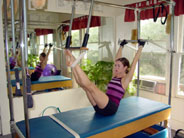 Joseph Pilates
considered the area of the torso between the lower ribs and the hips the
"Powerhouse" or center of the body. This corset of muscles forms the foundation
for all Pilates movements. A strong Powerhouse aligns and stabilizes the
pelvis and lumbar vertebrae, giving the practitioner a significant increase
in strength and control over all movements. This in turn improves performance,
posture, poise, grace and balance. Joseph Pilates
considered the area of the torso between the lower ribs and the hips the
"Powerhouse" or center of the body. This corset of muscles forms the foundation
for all Pilates movements. A strong Powerhouse aligns and stabilizes the
pelvis and lumbar vertebrae, giving the practitioner a significant increase
in strength and control over all movements. This in turn improves performance,
posture, poise, grace and balance.
The importance
of coordinating proper breathing with movement cannot be overstated. It
is 50% of the Pilates method. When you breathe properly, filling and emptying
the lungs completely, you have more stamina, feel more alive and alert,
and are better able to concentrate. The precise breathing patterns assigned
to each exercise serve to assist in the contraction of the intrinsic (core)
muscles of the Powerhouse and regulate the tempo and rhythm of the Pilates
exercises.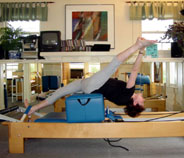
There are thirty-four
floor exercises that make up the Mat work. These exercises are based on
Yoga and indeed you will perform all of the Pilates floor exercises in
your study of yoga. There are 500 exercises for the machines Joseph Pilates
designed. These machines use springs of varying strength to provide the
resistance necessary to increase the density (strength) of muscle, bone
and connective tissue. Each spring also provides a variable resistance
that increases with leverage. This allows the practitioner to perform
the exercises through a full range of motion (flexibility) without causing
injury to the joints. This emphasis on full range of motion with increasing
resistance is the primary reason that the Pilates method lengthens the
muscles as it strengthens them.
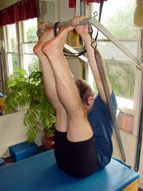 Joseph Pilates
called his system "Contrology" and required his students to perform controlled,
precise movements in a flowing style. He understood the biomechanical
advantages of improving posture to gain leverage and placed equal emphasis
on strength and flexibility to improve function (physical). He created
exercises to improve coordination (mental) and balancing exercises that
required a state of calm under stress (emotional). He encouraged the perseverance
(spirit) to flow from exercise to exercise without stopping to rest, thus
experiencing the benefits of muscular endurance and moderate aerobic activity.
This holistic approach to exercise results in significant weight loss,
a long, lean body, with a flatter stomach and lifted buttocks, improved
posture and an increase in cardiovascular health. This approach also develops
the ability to perform any activity in a graceful and fluid manner with
a minimum of effort. Joseph Pilates
called his system "Contrology" and required his students to perform controlled,
precise movements in a flowing style. He understood the biomechanical
advantages of improving posture to gain leverage and placed equal emphasis
on strength and flexibility to improve function (physical). He created
exercises to improve coordination (mental) and balancing exercises that
required a state of calm under stress (emotional). He encouraged the perseverance
(spirit) to flow from exercise to exercise without stopping to rest, thus
experiencing the benefits of muscular endurance and moderate aerobic activity.
This holistic approach to exercise results in significant weight loss,
a long, lean body, with a flatter stomach and lifted buttocks, improved
posture and an increase in cardiovascular health. This approach also develops
the ability to perform any activity in a graceful and fluid manner with
a minimum of effort.
"Contrology is complete coordination of mind, body and spirit..." -Joseph Pilates
2.
How is the Pilates method different from other forms of exercise?
The Pilates
participant is viewed as a true student of the method. The Pilates instructor
 considers each workout a "class" not unlike that of dance, martial arts
or yoga. The Pilates instructor focuses less on teaching repetitive movement
and focuses more on muscular reeducation and development of the body/mind
connection. considers each workout a "class" not unlike that of dance, martial arts
or yoga. The Pilates instructor focuses less on teaching repetitive movement
and focuses more on muscular reeducation and development of the body/mind
connection.
Many of the
exercise systems that are popular today focus on the large, superficial
muscle groups that control locomotion. An example of this would be pushing
and pulling movements with arms or legs. These movements are usually performed
through a small range of motion, which results in a decrease in flexibility,
limited function and short bulky muscles. Typically these systems exercise
the abdominals in a separate routine and focus predominantly on the rectus
abdominus (six pack) and obliques.
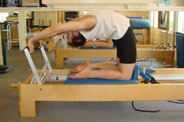 The Pilates
Method is a flowing style of exercise. It is designed to condition the
whole body simultaneously and uniformly. The Pilates student focuses on
increasing kinesthetic awareness and toning of the intrinsic muscles.
These are the deeper layers of muscles (core) that stabilize the skeleton.
This gives one greater leverage when engaging the extrinsic muscles that
are closer to the surface and are the larger muscles of locomotion. We
refer to this as "sequencing" because we initiate all movements by engaging
the stabilizing muscles before that of the "prime mover". This uniform
development combined with focused concentration, proper breathing, and
precise movements ensure that the body is aligned as it was designed to
be, with all joints supported by balanced weight and force. The Pilates
Method is a flowing style of exercise. It is designed to condition the
whole body simultaneously and uniformly. The Pilates student focuses on
increasing kinesthetic awareness and toning of the intrinsic muscles.
These are the deeper layers of muscles (core) that stabilize the skeleton.
This gives one greater leverage when engaging the extrinsic muscles that
are closer to the surface and are the larger muscles of locomotion. We
refer to this as "sequencing" because we initiate all movements by engaging
the stabilizing muscles before that of the "prime mover". This uniform
development combined with focused concentration, proper breathing, and
precise movements ensure that the body is aligned as it was designed to
be, with all joints supported by balanced weight and force.
"Each
muscle may cooperatively and loyally aid in the uniform development of
all our muscles. Developing minor muscles naturally helps to strengthen
major muscles." - Joseph Pilates
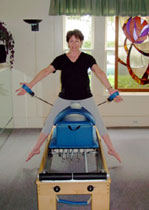 3.
What is the difference between the "Soft" and "Hard" styles of the Pilates
Method? 3.
What is the difference between the "Soft" and "Hard" styles of the Pilates
Method?
The use of the
titles "Soft style" and "Hard style" are a convenient way of describing
two approaches to any form of exercise. They are not exclusive to the
Pilates Method.
A Soft style
is a "restorative" approach to working out. Its intensity is light to
moderate. It has fewer exercises and is performed at a slower pace. The
student is allowed to rest for a moment between exercises, taking stock
of any changes, which may have occurred in alignment, sequencing, or ease
of movement. This is a very safe way to increase one's kinesthetic awareness
while correcting any muscular imbalances or movement patterns that may
impede proper alignment or performance.
The Soft style
is recommended for exercise rehabilitation, prenatal and postpartum, the
special needs of senior citizens and those new to formal exercise. All
new Pilates students, regardless of their fitness level, begin with the
Soft style in order to acquire a strong foundation in the fundamentals
of the Pilates Method.
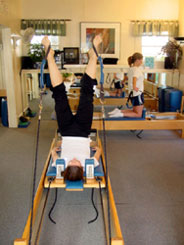 A Hard style
is a "stimulating" workout. It has more exercises than the Soft style
and the tempo is vigorous. The intensity is high and the student must
flow from exercise to exercise, performing choreographed transitions as
they make their way through the routine. The benefits of this flowing
style include a significant increase in muscular endurance and cardiovascular
health, a high caloric burn, excellent balance and coordination, and long,
lean flexible muscles, trained to fire in the proper sequence for grace
and ease of movement. A Hard style
is a "stimulating" workout. It has more exercises than the Soft style
and the tempo is vigorous. The intensity is high and the student must
flow from exercise to exercise, performing choreographed transitions as
they make their way through the routine. The benefits of this flowing
style include a significant increase in muscular endurance and cardiovascular
health, a high caloric burn, excellent balance and coordination, and long,
lean flexible muscles, trained to fire in the proper sequence for grace
and ease of movement.
"With body, mind, and spirit
functioning perfectly, as a coordinated whole, what else could
reasonably be expected other than an active, alert, disciplined person"-
Joseph Pilates
4.
Can I Lose Weight Doing the Pilates Method?
Yes, once you
have studied the Soft style long enough to gain expertise in the fundamentals.
This will require you to attend a minimum of two, one-hour sessions per
week. At this point you can begin to pick up the pace and intensity of
your Pilates routine and burn enough calories to make a noticeable change
in the ratio of body fat to lean muscle mass.
Within the first
five sessions (2 /1/2 weeks), you can expect to feel a positive change
in your body. The tone and flexibility of your muscles will have begun
to improve. You will be standing taller and moving with greater ease.
In twelve sessions (six weeks), you may notice your clothes are a little
loose and your friends and family will notice the difference. After forty-eight
sessions (six months) you will have made a profound change in the shape
of your body.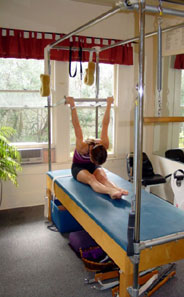
There isn't
anything magical about the Pilates Method. The old adage about burning
more calories than you consume will always be true. The fundamental principals
of biomechanics incorporated in Pilates are the same as those found in
many physical disciplines such as classical ballet, martial arts, and
yoga, but the emphasis the Pilates Method places on the lengthening of
the muscles while increasing their density will cause you to burn more
calories at rest and make you look thinner.
It is worth
noting our bodies are all about "adaptation". The degree to which your
body changes is in direct proportion to the intensity of your workout.
Simply put, if you are relatively comfortable while doing your workout,
your body will have no need to adapt and change. An effective Pilates
session will be challenging enough to encourage adaptation without being
a struggle as this will just create tension and interfere in the creation
of the Pilates body.
"If
you will faithfully perform your Contrology exercises regularly, only
four times a week for just three months, you will find your body development
approaching the ideal, accompanied by renewed mental vigor and spiritual
enhancements." - Joseph Pilates
5.
Can Anyone Do the Pilates Method?
Yes. The Pilates
exercises can be modified to match anyone's state of health, regardless
of age. If you are new to formal exercise, a professional athlete or dancer,
in a prenatal or postpartum period, recovering from surgery, or have chronic
pain, the Pilates Method will be of benefit.
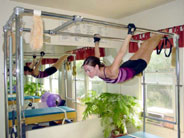 That said, it
is always recommended that you consult with your health professional before
beginning any exercise program. This will ensure that you have no preexisting
conditions that might make certain types of exercise inadvisable. That said, it
is always recommended that you consult with your health professional before
beginning any exercise program. This will ensure that you have no preexisting
conditions that might make certain types of exercise inadvisable.
"In ten sessions you will feel the difference, in twenty you will see the difference and in thirty you will have a whole new body"-Joseph Pilates
6.
Is the Pilates Method good for rehabilitation?
Yes. Joseph
Pilates began developing his theories of exercise rehabilitation and the
exercise machines we use while working with injured soldiers during WWI.
He claimed to be 50 years ahead of his time, and it appears he was correct.
He discovered the benefits of using variable resistance (bedsprings).
He taught both closed kinetic chain and stabilazation exercises and placed
an equal emphasis on strength and flexibility to return full function
to injured joints. He would even make his patients take walks right after
surgery to increase their circulation.
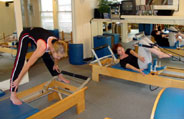 All the protocols
for exercise rehabilitation have existed within the body of Pilates' work
for over 75 years. Many physical therapists are obtaining a Pilates certification
and now take advantage of the hundreds of exercises created for this purpose.
All of the Pilates exercises can be modified into gentle, simple movements.
As the client's strength and mobility increases the exercises can be carefully
modified to increase the intensity of the workout until the client has
regained strength, stability and full range of motion. In many cases this
shortens the period of recovery or eliminates the need for a surgical
procedure. All the protocols
for exercise rehabilitation have existed within the body of Pilates' work
for over 75 years. Many physical therapists are obtaining a Pilates certification
and now take advantage of the hundreds of exercises created for this purpose.
All of the Pilates exercises can be modified into gentle, simple movements.
As the client's strength and mobility increases the exercises can be carefully
modified to increase the intensity of the workout until the client has
regained strength, stability and full range of motion. In many cases this
shortens the period of recovery or eliminates the need for a surgical
procedure.
Beyond its rehabilitative
effects, the Pilates Method can help prevent joint and muscle injuries.
Taking the "balanced body" approach to uniform muscle development, the
client can eliminate potential compensatory injuries by balancing the
muscular force around the joints, lengthening tight tendons, and reprogramming
ineffective or destructive movement habits.
There are many
therapeutic benefits to the Pilates Method. It has been used successfully
to treat complications from ankle, knee, hip and shoulder cuff injuries.
It aids in the recovery from stroke and other neurological events, and
it is an effective therapy for spinal issues such as: herniated or degenerated
discs, scoliosis, arthritis, sciatica, unstable sacral iliac joints, and
decompressing injured vertebra, helping to relieve nerve and disc pressure.
"Neither the mind nor the body is supreme one cannot be subordinate to the other"-Joseph Pilates
7.
Is the Pilates Method safe in pregnancy?
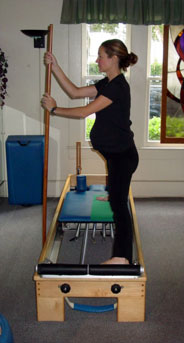 Yes, in those
with previous Pilates training. The expectant mother should always consult
with her primary care provider before beginning a new exercise program.
Postpartum training in Pilates is a wonderful way to tighten up the pelvic
floor and abdominals. Yes, in those
with previous Pilates training. The expectant mother should always consult
with her primary care provider before beginning a new exercise program.
Postpartum training in Pilates is a wonderful way to tighten up the pelvic
floor and abdominals.
During pregnancy
the body releases the hormones relaxin and progesterone which loosen the
pelvis and all other joints in preparation for childbirth. This joint
laxity increases the potential for joint and muscular injury. Pilates
strengthens the muscles that support the joints, and by increasing the
muscle tone and endurance, it can help counter the stresses in pregnancy.
Most women find that practicing Pilates results in fewer incidences of
backache, shortness of breath, constipation, varicose veins, fatigue,
and morning sickness.
It is best to
take a "restorative" approach to Pilates during pregnancy. This slow,
flowing style has a calming effect on your nervous system as it helps
you to develop good breath control, carry your pregnancy more comfortably
and strengthen your body for a smoother delivery and a faster return to
your prepregnancy body shape.
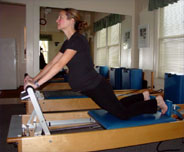 In the first
trimester, we will continue with the uniform development of your whole
body, while being careful to keep your core temperature and heart rate
at a safe level. In the second trimester, we will modify your workout
slightly by eliminating any prone positions (lying on stomach), and exercises
that are executed with just one leg, as this could harm the pelvic structures.
We will encourage you to do as many of the abdominal exercises as you
are able at this stage, and will continue to modify the exercises as your
balance and range of motion in forward bends begins to change. In the
third trimester, we will replace some of the more difficult abdominal
exercises and those that put you at risk of falling with more upper body
work. This will prepare you for some of the physical challenges of having
a newborn. In the first
trimester, we will continue with the uniform development of your whole
body, while being careful to keep your core temperature and heart rate
at a safe level. In the second trimester, we will modify your workout
slightly by eliminating any prone positions (lying on stomach), and exercises
that are executed with just one leg, as this could harm the pelvic structures.
We will encourage you to do as many of the abdominal exercises as you
are able at this stage, and will continue to modify the exercises as your
balance and range of motion in forward bends begins to change. In the
third trimester, we will replace some of the more difficult abdominal
exercises and those that put you at risk of falling with more upper body
work. This will prepare you for some of the physical challenges of having
a newborn.
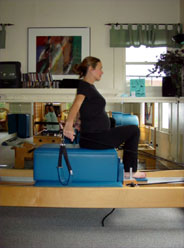 Taking this
calm, balanced approach to exercise with its focused concentration, breath
work and attention to detail is good for both mother and child. They will
share in the benefits gained from increased circulation of oxygen rich
blood, the regulation of hormones, and the rhythmic, flowing movements
that help to calm and center us mentally, emotionally and spiritually. Taking this
calm, balanced approach to exercise with its focused concentration, breath
work and attention to detail is good for both mother and child. They will
share in the benefits gained from increased circulation of oxygen rich
blood, the regulation of hormones, and the rhythmic, flowing movements
that help to calm and center us mentally, emotionally and spiritually.
Please inform
your Pilates instructor and your primary care provider immediately if
you experience any of the following danger signs at any time during pregnancy:
persistent severe headaches, dizziness, visual disturbances, elevated
pulse or blood pressure after exercise, chest pain, excessive fatigue,
persistent contractions, any sign of bloody discharge, sudden swelling
of ankles, hands and face, or unexplained abdominal pain. Beginning a
Pilates regime is not recommended in women who have no prior Pilates training.
"Physical fitness is the first requisite of happiness" - Joseph Pilates |
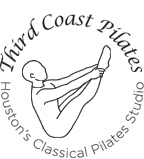

 Joseph Pilates
considered the area of the torso between the lower ribs and the hips the
"Powerhouse" or center of the body. This corset of muscles forms the foundation
for all Pilates movements. A strong Powerhouse aligns and stabilizes the
pelvis and lumbar vertebrae, giving the practitioner a significant increase
in strength and control over all movements. This in turn improves performance,
posture, poise, grace and balance.
Joseph Pilates
considered the area of the torso between the lower ribs and the hips the
"Powerhouse" or center of the body. This corset of muscles forms the foundation
for all Pilates movements. A strong Powerhouse aligns and stabilizes the
pelvis and lumbar vertebrae, giving the practitioner a significant increase
in strength and control over all movements. This in turn improves performance,
posture, poise, grace and balance.
 Joseph Pilates
called his system "Contrology" and required his students to perform controlled,
precise movements in a flowing style. He understood the biomechanical
advantages of improving posture to gain leverage and placed equal emphasis
on strength and flexibility to improve function (
Joseph Pilates
called his system "Contrology" and required his students to perform controlled,
precise movements in a flowing style. He understood the biomechanical
advantages of improving posture to gain leverage and placed equal emphasis
on strength and flexibility to improve function ( considers each workout a "class" not unlike that of dance, martial arts
or yoga. The Pilates instructor focuses less on teaching repetitive movement
and focuses more on muscular reeducation and development of the body/mind
connection.
considers each workout a "class" not unlike that of dance, martial arts
or yoga. The Pilates instructor focuses less on teaching repetitive movement
and focuses more on muscular reeducation and development of the body/mind
connection. The Pilates
Method is a flowing style of exercise. It is designed to condition the
whole body simultaneously and uniformly. The Pilates student focuses on
increasing kinesthetic awareness and toning of the intrinsic muscles.
These are the deeper layers of muscles (
The Pilates
Method is a flowing style of exercise. It is designed to condition the
whole body simultaneously and uniformly. The Pilates student focuses on
increasing kinesthetic awareness and toning of the intrinsic muscles.
These are the deeper layers of muscles ( 3.
What is the difference between the "Soft" and "Hard" styles of the Pilates
Method?
3.
What is the difference between the "Soft" and "Hard" styles of the Pilates
Method? A Hard style
is a "stimulating" workout. It has more exercises than the Soft style
and the tempo is vigorous. The intensity is high and the student must
flow from exercise to exercise, performing choreographed transitions as
they make their way through the routine. The benefits of this flowing
style include a significant increase in muscular endurance and cardiovascular
health, a high caloric burn, excellent balance and coordination, and long,
lean flexible muscles, trained to fire in the proper sequence for grace
and ease of movement.
A Hard style
is a "stimulating" workout. It has more exercises than the Soft style
and the tempo is vigorous. The intensity is high and the student must
flow from exercise to exercise, performing choreographed transitions as
they make their way through the routine. The benefits of this flowing
style include a significant increase in muscular endurance and cardiovascular
health, a high caloric burn, excellent balance and coordination, and long,
lean flexible muscles, trained to fire in the proper sequence for grace
and ease of movement.
 That said, it
is always recommended that you consult with your health professional before
beginning any exercise program. This will ensure that you have no preexisting
conditions that might make certain types of exercise inadvisable.
That said, it
is always recommended that you consult with your health professional before
beginning any exercise program. This will ensure that you have no preexisting
conditions that might make certain types of exercise inadvisable.  All the protocols
for exercise rehabilitation have existed within the body of Pilates' work
for over 75 years. Many physical therapists are obtaining a Pilates certification
and now take advantage of the hundreds of exercises created for this purpose.
All of the Pilates exercises can be modified into gentle, simple movements.
As the client's strength and mobility increases the exercises can be carefully
modified to increase the intensity of the workout until the client has
regained strength, stability and full range of motion. In many cases this
shortens the period of recovery or eliminates the need for a surgical
procedure.
All the protocols
for exercise rehabilitation have existed within the body of Pilates' work
for over 75 years. Many physical therapists are obtaining a Pilates certification
and now take advantage of the hundreds of exercises created for this purpose.
All of the Pilates exercises can be modified into gentle, simple movements.
As the client's strength and mobility increases the exercises can be carefully
modified to increase the intensity of the workout until the client has
regained strength, stability and full range of motion. In many cases this
shortens the period of recovery or eliminates the need for a surgical
procedure. Yes, in those
with previous Pilates training. The expectant mother should always consult
with her primary care provider before beginning a new exercise program.
Postpartum training in Pilates is a wonderful way to tighten up the pelvic
floor and abdominals.
Yes, in those
with previous Pilates training. The expectant mother should always consult
with her primary care provider before beginning a new exercise program.
Postpartum training in Pilates is a wonderful way to tighten up the pelvic
floor and abdominals. In the first
trimester, we will continue with the uniform development of your whole
body, while being careful to keep your core temperature and heart rate
at a safe level. In the second trimester, we will modify your workout
slightly by eliminating any prone positions (
In the first
trimester, we will continue with the uniform development of your whole
body, while being careful to keep your core temperature and heart rate
at a safe level. In the second trimester, we will modify your workout
slightly by eliminating any prone positions ( Taking this
calm, balanced approach to exercise with its focused concentration, breath
work and attention to detail is good for both mother and child. They will
share in the benefits gained from increased circulation of oxygen rich
blood, the regulation of hormones, and the rhythmic, flowing movements
that help to calm and center us mentally, emotionally and spiritually.
Taking this
calm, balanced approach to exercise with its focused concentration, breath
work and attention to detail is good for both mother and child. They will
share in the benefits gained from increased circulation of oxygen rich
blood, the regulation of hormones, and the rhythmic, flowing movements
that help to calm and center us mentally, emotionally and spiritually.